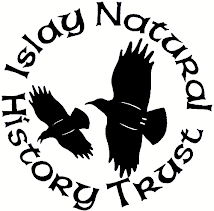A Great Delight of flowers was had at Killinallan
A less than promising day weather-wise did not dampen
enthusiasm for our dune excursion to Killinallan on Sunday, 13 keen adults and
children enjoyed seeing the Redshank and Oystercatchers along the shoreline and
counting all the Grey Seals bobbing about in the water intent on watching us and
what we were doing.
 |
| Searching the pools for pond skaters |
The brackish pools amongst the saltmarsh had small shoals of
stickleback and pond skaters on the surface.
Amongst the saltmarsh vegetation were common spike rush, sedges and the
corriander tasting Sea Arrowgrass.
As we crossed the moist threshold into the dryer dune
grassland we had Ragged Robin, Marsh Lousewort and Grass of Parnassus, the
beautiful simplicity of its flower, with its stem hugged by its single heart
shaped leaf always a pleasure. The dunes
were a patchwork of species with Lady's Bedstraw; Hairy Thyme; Bird's Foot
Trefoil; Eyebright; Mouse-ear Hawkweed; Daisy; Buttercup; White and Red Clover;
Self-Heal. These standard array of dune
species were peppered with the small white flowers of Fairy Flax; the subtle
blues of Milkwort; and the first mauve flowers of Devil's Bit Scabious.
 |
| A chance encounter with a Frog |
Where the ground was wetter Meadow Sweet,
Yellow Flag, Tufted Vetch, Water Mint, Valerian, and Marsh Thistle all came
into play. The damp conditions also favoured the occasional frog.
 |
| Burnet Rose |
In a great marshy depression there is a host of other
species, Burnet Rose spreads out in an extended patch alongside Black Bog Rush,
upon which were the vacated cocoon cases of the Six Spot Burnet moth, which has
now pupated and flying in profusion across the dunes. Marsh Pennywort peppered the whole dune slack
area and an occasional spike of Marsh Arrowgrass.
 |
| Six-spot Burnet Moth on Tufted Vetch |
We were all really looking forward to an orchid bonanza and
as always Killinallan did not disappoint, our first encounters were Pyramidal
Orchid on the dryer dune area alongside Common Spotted Orchid and the deep
purple of Northern Marsh Orchid. The bold pinks and purples were easy to spot against
the grassland but it was not long before the eyes began to pick out the subtle
colours of the Frog Orchid. Then we
began to find Fragrant Orchid, getting on hands and knees to double check the
scented nature of the flowers. When we
moved into the marshy dune slack area, those orchids which favour a more damp
habitat were soon spotted - Common Twayblade, its two wide leaves enveloping
the base of the stem. This damp spring
has meant that the moist nature of the slack has affected the conditions
further than in a dry season and we were delighted to spot many specimens of
the beautiful Marsh Helleborine, one of my favourite orchids. So not bad for a few hours, seven orchid species
all in great conditions. 41 plant
species, named though we didn't delve deep into grasses. We also had a good number of Shaggy Ink-cap
mushrooms protruding for old cowpats.
 |
| Marsh Helleborine |
 |
| Northern Marsh orchid |
 |
| Pyramidal Orchid |
 |
| A cluster of Frog Orchid |
We also had a good number of Shaggy Ink-cap mushrooms protruding for old cowpats.
 |
| Shaggy Ink-cap |
The conditions were not good for flying insects and the only
six legged beasties we found were the Six-spot Burnet moths frequenting the
flower heads and a single Common Blue male clinging onto the vegetation for
fear of the wind whipping it away!
A wonderful afternoon in great company, thanks
to those who joined us and please feel encouraged to join us over the summer,
lots to see and lots to learn. Next
Sunday is a Geology special, the rocks on the Oa, meet at the RSPB American
monument car park (2pm).
Fiona MacG























































